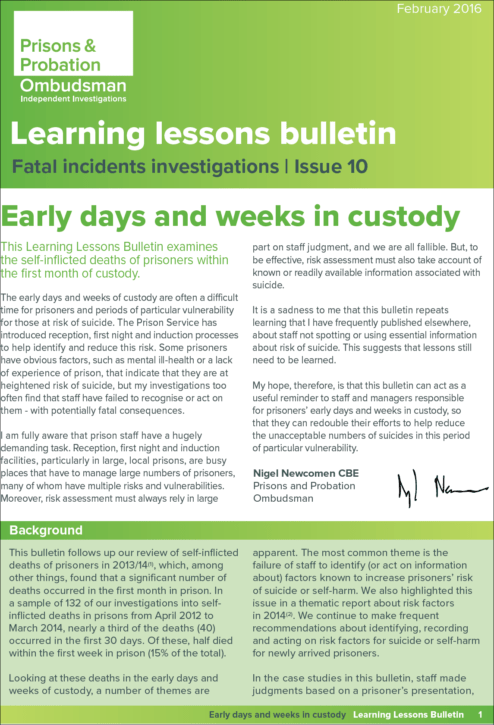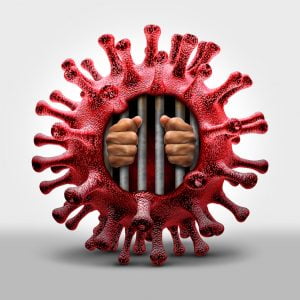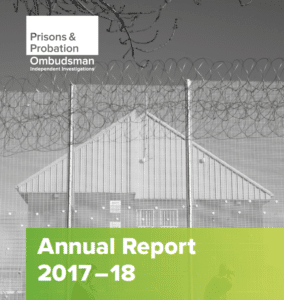Early days and weeks critical
It is the grim job of the Prisons and Probation Ombudsman to investigate every prison suicide (the horrible bureaucratic term for which is “fatal incident”) to learn lessons to try to reduce the ever growing number of these terrible tragedies.
Last week (16 February 2016), the PPO, Nigel Newcomen, published the tenth issue of his Learning Lessons bulletin which focuses on the high risk period of the early days and weeks in custody.
One in three suicides in first month
This bulletin follows up a previous review of self-inflicted deaths of prisoners in 2013/14, which found that a significant number of deaths occurred in the first month in prison. In a sample of 132 of our investigations into self-inflicted deaths in prisons from April 2012 to March 2014, nearly a third of the deaths (40) occurred in the first 30 days. Of these, half died within the first week in prison (15% of the total).
The importance of risk factors
The bulletin prioritises the importance of staff identifying and acting on risk factors rather than relying on how they think the prisoner looks or on the fact that she or he says they haven’t got suicidal thoughts.
It highlights the key issues through three (anonymised) case studies.
PPO investigations into deaths in the early weeks of custody frequently uncover failures to identify risk factors (such as a history of suicidal behaviour or the circumstances of their offence), and therefore to begin Prison Service suicide and self-harm prevention procedures (known as ACCT). This emphasises the importance of getting this right early on – or there may not be another chance to make another formal assessment of risk.
The Ombudsman notes that failings in reception processes have been a feature of many recent prison inspections and states:
While assessment of risk of suicide and self-harm needs to happen before, during and after someone arrives in prison, the assessment process that should take place in reception when a prisoner first arrives is the best time for risks to be identified and recorded. Too often, staff in prison receptions miss obvious signs of risk.
The first case study sadly bears out the importance of this warning; no ACCT measures were put in place despite these facts:
- He was charged with a violent offence against his partner
- There was clear information that he had recently made a serious suicide attempt
- He was a young man with relationship difficulties
- He had arrived with a warning about his risk
- His family, probation officer and solicitor ALL subsequently contacted the prison to alert staff about his risk of suicide.
Clearly, prison staff are under unprecedented pressure given the 30% reduction in staffing levels over the last five years (while the prison population has remained roughly the same), nevertheless this seems an unforgivable situation, certainly from the point of view of this young man’s family and friends.

Other lessons
The Ombudsman highlights the importance of the induction process as another key opportunity to identify risk of suicide:
Effective induction involves a lot more than simple provision of information. Regular contact with staff is important. Staff need to talk to the prisoner and check that they are coming to terms with their situation.
The bulletin features a case study with a man who hung himself after two weeks in prison who received no induction at either of the two prisons he was sent to.
The third case study identifies another particularly high risk period – when prisoners have been recalled to prison. In this case, a man hanged himself after initially being told he was being recalled for 28 days but subsequently being informed that he might have to serve a number of extra years on his sentence. Despite presenting as tearful and upset and being referred to mental health services twice, he did not see any mental health professional before hanging himself 12 days after his recall.
Conclusion
In conclusion, I want to quote part of the Ombudsman’s sad introduction to this bulletin which reminds us all that so many of these deaths could be prevented:
It is a sadness to me that this bulletin repeats learning that I have frequently published elsewhere, about staff not spotting or using essential information about risk of suicide. This suggests that lessons still need to be learned.









4 Responses
It is true that staff need to communicate with all prisoners on their reception and ongoing through their sentence, but they also need as much information on the prisoner on their arrival
However given the reduction in staff, and the pressure they are under, the Prison Department need to look at levels off staff and increase them.
Thanks very much for your comment. I don’t think anyone could disagree that the large reductions in staffing are related to increasing suicides and assaults – on both prisoners and staff.
No you are incorrect, it is nothing to do with reduction in staff, it is to do with the Governors not giving their staff training fit for purpose. In my Opinion a bad apple at the top will rot all the others, this is where it has all gone wrong and you will hear of me quite soon as I will not rest until I have proved this to be the case !!
STATISTICS RARELY LIE AT THE MOMENT THE INJUSTICE SYSTEM is locking people up on the knee jerk reaction of vengeance and simple or simplistic thinking. Reoffending rates are getting much higher and are very high an average of 70%. Remember cut reoffending and it cuts jobs for prison officers and the whole injustice system, where is the incentive to cut reoffending? Prison is a business it employs people as does the whole of the injustice system. It is proven in other countries like Norway and the Netherlands reoffending is greatly reduced by certain ways of treating and rehabilitating prisoners, but here all they want is for the Sun reader mentality to be satisfied and for revenge and punishment so people are employed. People are going into prison and coming out worse this is barbaric and symptomatic of the way this country is going and l guarantee it will be worse after Brexit. Prison is a breeding ground for producing worse offenders than before they went in. Do we really want this? The answer is to copy and learn from the Netherlands and Norway etc. it may not satisfy the primal urges of people who are judgmental and vengeful but it lowers reoffending and making people worse greatly.